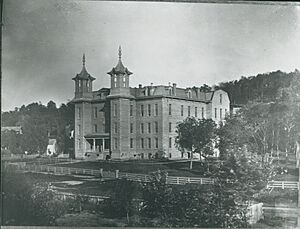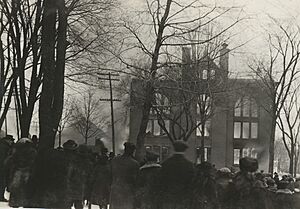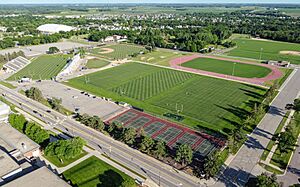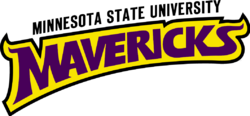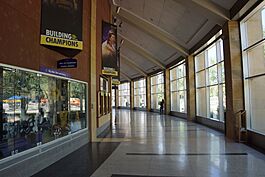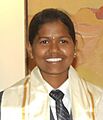Minnesota State University, Mankato facts for kids
 |
|
|
Former names
|
Mankato Normal School (1868–1921) Mankato State Teachers College (1921–1957) Mankato State College (1957–1975) Mankato State University (1975–1998) |
|---|---|
| Motto | Big Ideas. Real-world Thinking. |
| Type | Public university |
| Established | 1868 |
|
Parent institution
|
Minnesota State system |
| Accreditation | HLC |
| Endowment | $97 million (2024) |
| Budget | $264 million (2019) |
| President | Edward Inch |
| Provost | David Hood |
|
Academic staff
|
700 |
|
Total staff
|
1,600 |
| Students | 15,251 (Fall 2024) |
| Location |
,
,
United States
44°08′49″N 93°59′53″W / 44.147°N 93.998°W |
| Campus | Mid-size city 303 acres (123 ha) |
| Newspaper | The Reporter |
| Colors | Purple Gold |
| Nickname | Mavericks |
|
Sporting affiliations
|
NCAA Division II – NSIC NCAA Division I - CCHA, WCHA |
| Mascot | Stomper |
Minnesota State University, Mankato (often called MNSU or Minnesota State) is a large public university in Mankato, Minnesota. A public university is a school funded by the state government. It is the second-largest university in Minnesota. More than 145,000 people who studied here now live all over the world.
The university started in 1868. It is the second-oldest school in the Minnesota State Colleges and Universities system. Many people see it as a very important school in the system. It was first called "Mankato Normal School."
Minnesota State offers many different study programs. Students can choose from over 130 bachelor's degrees. There are also more than 80 master's programs and 4 doctoral programs. The university has two smaller campuses. One is in Edina and another in Owatonna. You can also earn degrees online. In 2023, the university started a new program called MinnPoly. This made it Minnesota's first polytechnic institute. A polytechnic institute focuses on applied sciences and technology.
The university's sports teams are called the Minnesota State Mavericks. They play in 21 different sports. Most teams compete at the NCAA Division II level. This is part of the Northern Sun Intercollegiate Conference. However, the men's and women's ice hockey teams play at the higher NCAA Division I level. The men's team is in the Central Collegiate Hockey Association (CCHA). The women's team is in the Western Collegiate Hockey Association (WCHA).
Contents
University History: How it Grew
Early Years: Training Teachers (1860–1921)
By 1858, leaders in Minnesota saw a need for more schools. In 1860, they decided to create "normal schools." These schools would train teachers. Mankato was chosen as one of the locations. The people of Mankato raised money to help start the school.
The school officially opened in 1868. It was called "Mankato Normal School." Only 27 students attended at first. Its main goal was to train teachers for small schools in southern Minnesota. Early classes included math, science, and how to teach. The first building for the school was started in 1869.
Most students at Mankato Normal School were women. In 1872, a woman named Julia Sears became the principal. This was a big deal because she was the first woman to lead a public college in the U.S. However, she was later replaced by a man. Students and local people were upset. This event was called the "Sears Rebellion." Students protested to support Julia Sears. Today, a building on campus is named after her.
Becoming a College and Growing After WWII (1921–1957)
By 1921, the school had grown a lot. It started offering four-year degrees. So, its name changed to "Mankato State Teachers College." The original main building burned down in 1922. A new one was finished in 1924.
During World War II, fewer students attended. After the war, many more students enrolled. The college grew very quickly. The original campus was in a lower part of Mankato. It was too small for all the new students. So, the college got old Army buildings to use for a short time.
In the late 1950s, work began on a brand new campus. This new campus was built on a bluff above the river valley. It is known as the Highland Campus. A special school called the Wilson School was built there. It was used to try out new teaching ideas for younger students. This helped future teachers learn new methods.
Becoming a University (1957–1995)
In 1957, the school's purpose had expanded. It was no longer just for teachers. It offered many different four-year college programs. So, its name changed again to "Mankato State College." By the 1960s, the school was growing so fast that people wanted it to become a university.
In 1975, the college officially became "Mankato State University." This change happened because the number of students had grown to 12,000. After this, the university added many new programs. These included science, technology, engineering, and health studies. The university also combined its two campuses into one larger campus.
Modern Era: New Degrees and Name (1995–Present)
In 1995, all seven state universities in Minnesota joined a new system. It was called the Minnesota State Colleges and Universities system. In 1998, the university's name changed to "Minnesota State University, Mankato." This new name helped more people across the Midwest recognize the school. The president at the time wanted it to be "the other great public university in Minnesota."
A big step happened in 2007. The university was allowed to start offering doctoral degrees. These are the highest degrees you can earn. This showed how much the university had grown and improved.
What Students Study (Academics)
| Forbes | 344 |
|---|---|
Minnesota State offers many different programs. There are over 130 bachelor's degrees. These are for students just starting college. There are also more than 85 graduate programs for students who want to study more. Every undergraduate program includes basic classes like math, writing, and computer skills.
Each year, over 3,000 students earn degrees from Minnesota State. Most graduates find jobs in their field. Many also continue their education within a year of graduating.
How the University is Organized
The university is divided into seven main colleges. Each college focuses on different subjects. For example, there is a College of Business and a College of Education.
- College of Allied Health and Nursing
- College of Business
- College of Education
- College of Humanities & Social Sciences
- College of Science, Engineering and Technology
- College of Graduate Studies and Research
- College of Extended Learning
Special Programs and Centers
Minnesota State has special programs that are unique. It was the first school in the country to offer a Master of Fine Arts degree in forensics. This is the study of science used in solving crimes. It also had one of the first programs in urban studies. This program helps students learn about city planning and management.
The Aviation and Airport Management program is the only one of its kind in Minnesota. It helps students become pilots or work in airport management. Graduates often get jobs with major airlines like Delta Air Lines and Sun Country Airlines. They can even get hired before they finish school.
University Campus
Main Campus Buildings and Fields
The main campus of Minnesota State is large. It has 30 buildings spread over 303 acres. This includes student housing, classrooms, and libraries. There are also two observatories for studying stars. The campus has research stations for new energy sources. You can find a recreation center, sports fields, and a student center. The university's hockey teams also use other arenas nearby.
Where Students Live
Minnesota State has five places for students to live. These are called residence communities. They can house up to 2,900 students. Living on campus is not required. There are also special "Learning Community" programs. These groups of students live together based on their classes or hobbies.
Other Campuses and Centers
Edina Campus
This campus is in Edina, a suburb of the Twin Cities. It serves students from that area. It offers 12 undergraduate programs. These include bachelor's degrees and teaching licenses. The campus also has 23 graduate programs.
Owatonna Campus
The Owatonna College and University Center was built to help students in the Owatonna area. This campus is a team effort. Minnesota State University, Mankato works with other colleges here. They offer different types of classes, from basic college courses to advanced studies. About 4,000 students take classes here each year.
Normandale Partnership Center
In 2012, Minnesota State started a partnership with Normandale Community College. This center in Bloomington offers specific bachelor's degrees. Some programs started here have now expanded to other colleges in the Minnesota State system.
Student Life
| Race and ethnicity | Total | ||
|---|---|---|---|
| White | 72% |
|
|
| International student | 9% |
|
|
| Black | 6% |
|
|
| Hispanic | 6% |
|
|
| Asian | 3% |
|
|
| Two or more races | 3% |
|
|
| Unknown | 1% |
|
|
| Economic diversity | |||
| Low-income | 24% |
|
|
| Affluent | 76% |
|
|
Mankato is known as a "college town." This means a large part of the people living there are college students. In 2017, Mankato was ranked the second-best college town in the country.
Student Groups and Clubs
Students at Minnesota State can join over 200 different groups. These include academic clubs, sports teams, and leadership groups. There are also fraternities and sororities. These are social organizations for college students.
Campus Media
Student Newspaper
The Reporter is the university's student-run newspaper. It started in 1926. It covers sports, campus news, and student opinions. New issues come out every week during the school year.
Radio Station
KMSU 89.7FM is the official radio station for Minnesota State. It began broadcasting in 1963.
Centennial Student Union
The Centennial Student Union (CSU) is a big building that opened in 1967. It is a central place on campus. Many university offices are located here. These include student activities, the counseling center, and the campus bookstore.
Student Activities
The Student Activities office helps students get involved. They manage student organizations and community service. They also plan fun events for the campus. These include homecoming concerts and a haunted house.
LGBT Center
Minnesota State has one of the oldest LGBT resource centers for students in the country. It started in 1977. This center provides support for students who are lesbian, gay, bisexual, or transgender. The Advocate magazine named Minnesota State one of the top 100 campuses for LGBT students.
Sports Teams (Athletics)
The Minnesota State Mavericks have 18 different sports teams. More than 650 students play sports for the university each year. Teams include men's and women's hockey, basketball, football, baseball, and more.
The men's and women's ice hockey teams play in NCAA Division I. This is the highest level of college sports. Other university teams compete in NCAA Division II. This is part of the Northern Sun Intercollegiate Conference.
The school mascot is Stomper the Maverick. He is a fun character of a wild steer. The school colors are purple and gold.

Minnesota State sports teams have done very well in national competitions. They have won many championships in different sports. Since 1993, the Mavericks have won the most individual national championships in their conference. In 2024, the men's and women's basketball teams both won the Division II national championship. This was the first time in 40 years that one school won both titles in the same year!
The university has a fight song called "The Minnesota State Rouser." It is played at all sports events. The marching band is called the "Maverick Machine." They help create excitement and school spirit.
The Minnesota Vikings football team used to hold their summer training camp at Minnesota State. This happened every year from 1966 to 2017. Thousands of fans would come to watch them practice. The Vikings now have a scholarship for Minnesota State students.
Sports Facilities Upgrades
The Taylor Center opened in 2000. It was built with money donated by a former student, Glen Taylor. This building has 4,800 seats. It is home to the basketball, volleyball, and wrestling teams. The Taylor Center also hosts graduation ceremonies, concerts, and lectures.
Famous People from Minnesota State
-
Tim Walz (M.S., 2001) – The current governor of Minnesota
-
Julia Sears – A leader in education and women's rights
-
Malavath Poorna – An Indian mountain climber, the youngest female to climb Mount Everest
-
Theresa Greenfield (B.A., 1987) – A candidate for the U.S. Senate in 2020
See also
 In Spanish: Universidad Estatal de Minnesota para niños
In Spanish: Universidad Estatal de Minnesota para niños
- List of colleges and universities in Minnesota


